Sorry for too long question but I'll try to be clear as possible about the problem.
I am trying to do fitting in different groups in data and trying to get fitting coefficients for each group.
I looked around but could not exactly the same problem but found some similar posts like below,
Trying to fit data with R and nls on a function with a condition in it
But it seems that the fitting doesn't seem to care the conditional setting so I am getting the same fitting coeffs for different groups.(This is also the same case for my real data.)
basically, what try to do is use different set of fitting coefficients if gr==a fit that group else fit gr==b.
I am using nlsLM from minpack.lm package since I also need to set the starting values for fitting coefs.
Here is the code which I have tried:
library(minpack.lm)
set.seed(95)
df <- data.frame(gr=rep(seq(1,2),each=10),sub_gr=rep(rep(c("a","b"),each=5),2),
y = rep(c(sort(runif(5,0,0.5),decreasing=TRUE), sort(runif(5,0,0.5),,decreasing=TRUE)),2),
x = rep(c(seq(0.1,0.5,0.1)),4))
#creating empty list to fill with fitting coefficients afterwards based on @Hack-R solution Error: Results are not data frames at positions:
empty_dat <- structure(list(x = numeric(0), y = numeric(0), gr = integer(0), sub_gr = character(0),
pred_fit = numeric(0), k_a = numeric(0), k_b = numeric(0),
t_a = numeric(0), t_b= numeric(0)), class = "data.frame")
#do the fitting in groups
for(x in unique(df$gr)){
#trycatch to
fit <- tryCatch(nlsLM(y~ifelse(sub_gr=='a', k_a*x+t_a, k_b*x+t_b),
data=df[df$gr==x,],start=c(k_a=0.3,k_b=0.4,t_a=0.1,t_b=0.2),
lower = c(0.05, 0.05, 0,0),
upper = c(1,1,1,1),
trace=T,na.action=na.omit, control = nls.lm.control(maxiter=100)),error=function(e) NULL)
if(!("NULL" %in% class(fit))){
pred_fit <- predict(fit, newdata =df$x)
coefs_fit <- data.frame(k_a=coef(fit)[1],k_b=coef(fit)[2],t_a=coef(fit)[3], t_b=coef(fit)[4])
#filling empty_data with coefs and df's original values
empty_dat <- rbind(empty_dat,data.frame(df[df$gr==x,],coefs_fit,pred_fit,row.names=NULL))
}
}
empty_dat
gr sub_gr y x k_a k_b t_a t_b pred_fit
1 1 a 0.28792044 0.1 0.05 0.05 0.1343742 0.2156747 0.1393742
2 1 a 0.24443957 0.2 0.05 0.05 0.1343742 0.2156747 0.1443742
3 1 a 0.07585577 0.3 0.05 0.05 0.1343742 0.2156747 0.1493742
4 1 a 0.03522243 0.4 0.05 0.05 0.1343742 0.2156747 0.1543742
5 1 a 0.02654922 0.5 0.05 0.05 0.1343742 0.2156747 0.1593742
6 1 b 0.48498563 0.1 0.05 0.05 0.1343742 0.2156747 0.2206747
7 1 b 0.18702842 0.2 0.05 0.05 0.1343742 0.2156747 0.2256747
8 1 b 0.15186749 0.3 0.05 0.05 0.1343742 0.2156747 0.2306747
9 1 b 0.15003048 0.4 0.05 0.05 0.1343742 0.2156747 0.2356747
10 1 b 0.07638354 0.5 0.05 0.05 0.1343742 0.2156747 0.2406747
11 2 a 0.28792044 0.1 0.05 0.05 0.1343742 0.2156747 0.1393742
12 2 a 0.24443957 0.2 0.05 0.05 0.1343742 0.2156747 0.1443742
13 2 a 0.07585577 0.3 0.05 0.05 0.1343742 0.2156747 0.1493742
14 2 a 0.03522243 0.4 0.05 0.05 0.1343742 0.2156747 0.1543742
15 2 a 0.02654922 0.5 0.05 0.05 0.1343742 0.2156747 0.1593742
16 2 b 0.48498563 0.1 0.05 0.05 0.1343742 0.2156747 0.2206747
17 2 b 0.18702842 0.2 0.05 0.05 0.1343742 0.2156747 0.2256747
18 2 b 0.15186749 0.3 0.05 0.05 0.1343742 0.2156747 0.2306747
19 2 b 0.15003048 0.4 0.05 0.05 0.1343742 0.2156747 0.2356747
20 2 b 0.07638354 0.5 0.05 0.05 0.1343742 0.2156747 0.2406747
as we can see clearly the coefficients k_a, k_b and t_a , t_b is identical for each gr and sub_gr.
If I want to plot the result and predicted values of fitting
fitting lines telling the different story:))
library(ggplot2)
ggplot(df, aes(x=x, y=y,col=sub_gr,shape=sub_gr)) +
geom_point(size=6,alpha=0.8,stroke=1.4) +
theme_bw()+
facet_wrap(~gr,scales='free')+
scale_color_manual(values=c("blue","red"))+
geom_line(data=empty_dat,aes(x=x,y=pred_fit,group=sub_gr,col=sub_gr))
